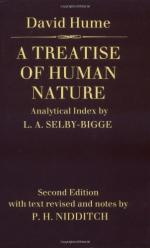There are few or no mathematicians, who defend the hypothesis of indivisible points; and yet these have the readiest and justest answer to the present question. They need only reply, that lines or surfaces are equal, when the numbers of points in each are equal; and that as the proportion of the numbers varies, the proportion of the lines and surfaces is also varyed. But though this answer be just, as well as obvious; yet I may affirm, that this standard of equality is entirely useless, and that it never is from such a comparison we determine objects to be equal or unequal with respect to each other. For as the points, which enter into the composition of any line or surface, whether perceived by the sight or touch, are so minute and so confounded with each other, that it is utterly impossible for the mind to compute their number, such a computation will Never afford us a standard by which we may judge of proportions. No one will ever be able to determine by an exact numeration, that an inch has fewer points than a foot, or a foot fewer than an ell or any greater measure: for which reason we seldom or never consider this as the standard of equality or inequality.
As to those, who imagine, that extension is divisible in infinitum, it is impossible they can make use of this answer, or fix the equality of any line or surface by a numeration of its component parts. For since, according to their hypothesis, the least as well as greatest figures contain an infinite number of parts; and since infinite numbers, properly speaking, can neither be equal nor unequal with respect to each other; the equality or inequality of any portions of space can never depend on any proportion in the number of their parts. It is true, it may be said, that the inequality of an ell and a yard consists in the different numbers of the feet, of which they are composed; and that of a foot and a yard in the number of the inches. Bat as that quantity we call an inch in the one is supposed equal to what we call an inch in the other, and as it is impossible for the mind to find this equality by proceeding in infinitum with these references to inferior quantities: it is evident, that at last we must fix some standard of equality different from an enumeration of the parts.
There are some [See Dr. Barrow’s mathematical lectures.], who pretend, that equality is best defined by congruity, and that any two figures are equal, when upon the placing of one upon the other, all their parts correspond to and touch each other. In order to judge of this definition let us consider, that since equality is a relation, it is not, strictly speaking, a property in the figures themselves, but arises merely from the comparison, which the mind makes betwixt them. If it consists, therefore, in this imaginary application and mutual contact of parts, we must at least have a distinct notion of these parts, and must conceive their contact. Now it is plain, that in this conception we would run




